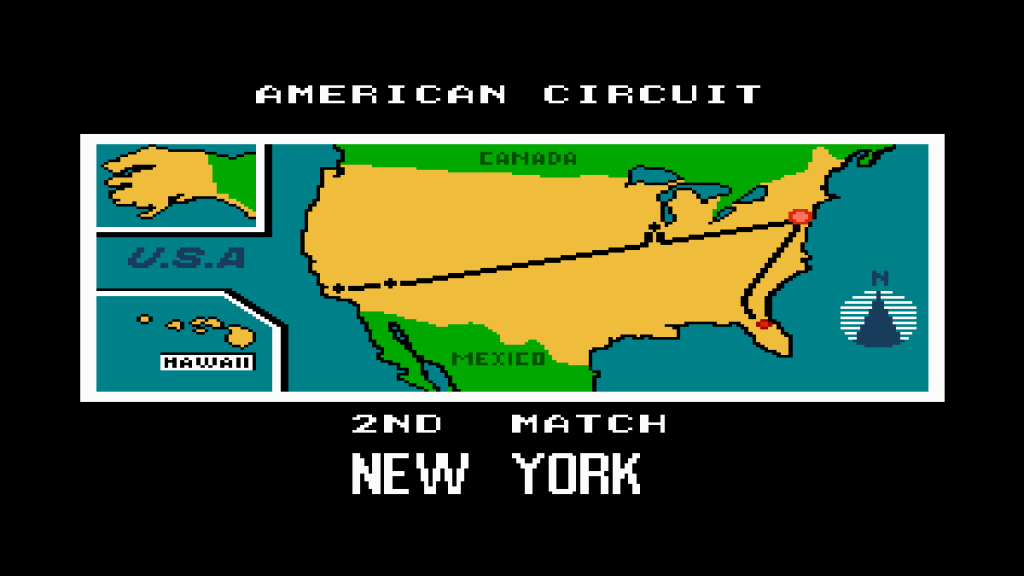There aren’t very many volleyball video games. Granted, volleyball isn’t as popular a sport as football, basketball, baseball, or hockey– but it’s played a lot on beaches, in backyards, and in physical education classes. The game being covered this time, After Further Review, is the best of the volleyball games available– and has been for more than three decades now.

Super Spike V’Ball is based on a little-known Technos coin-op called V’Ball (also known as Championship V’Ball), which was released in the West by Taito in 1988– similar to how Taito picked up Mat Mania for release back in 1985. The NES conversion, which was also developed by Technos, adds a few wrinkles to the home game to add replay value and make it stand out from its coin-op counterpart.
For the uninitiated, volleyball matches are played to 15 points. There must also be a two-point gap between the winner and the loser– so, if a game is 15-14, the teams play on. There are boundaries of play, and if the ball lands out of bounds, a point is awarded to the team that didn’t touch it last. Most importantly, each team can touch the ball only three times before it clears the net for the other team to play it. The bump-set-spike strategy is usually employed; the player who receives the serve “bumps” the ball into the air toward a teammate, who then “sets” up the receiving player by lofting the ball in the air high enough for that player to “spike” the ball by driving it into a non-covered zone on the other side of the net or at a defender who may be unable to handle it. It sounds complicated, but it only takes a few matches to understand the flow of the game.

Super Spike V’Ball can be played alone or with up to a total of four players, provided that a Four Score or an NES Satellite accessory is available for the third and fourth players. There are four teams of two athletes for players to pic from. George and Murphy are the most balanced pair. Al and John are slower but have stronger spiking power. Ed and Michael are speedsters, but have less power. Finally, the Double Dragon twins, Billy (not Bimmy) and Jimmy are great at blocking spike attempts at the net or handling strong spikes without the ball flying out of play. After selecting teams, there are several modes of play to choose from including single-match exhibitions and two short tournaments. Exhibitions can be played with up to four players. The American Circuit and World Cup tournament events play at five different locations that features gradually more difficult computer-controlled opponents. Consider the American Circuit as easy-to-standard difficulty, while the World Cup starts out on medium difficulty and ramps up considerably by the final match.
The basic play controls are simple to get the hang of. The A button hits the ball, whether it’s in a bump, set, or spike situation. The B button jumps, which is used for more advanced jump serves or to try and block spikes right at the net. A cursor shows where the ball is heading, so players can move accordingly with the D-pad. Powering up a spike shot is imperative, especially against tough opponents. Hammering on the B button while the spiking player is airborne turns a spike shot into a titular Super Spike, which usually ends up sending the defending player flying while KABOOM!! displays on the screen. Connecting with these Super Spike shots is quite satisfying, especially if the ball careens off of the defending player way up into the air and out of bounds. Conversely, Super Blocks at the net can be attempted by defending players by rapidly pressing the B button while in the air during a jump to try and block. The advanced controls require a bit of timing and rapid button presses to pull off, but once they’re learned, they make any team formidable on the hot sand.

Super Spike V’Ball looks very good, by NES standards. The players are fairly large sprites and animate well. Serves, sets, spikes, and dives for the ball look fairly convincing. The beach settings vary, based on the city they’re taking place in. Chicago, for example, takes place at night and the stands are decked out to show love for pizza and football. Las Vegas also goes on at night, basking in the glow of neon lights from Gold Castle casinos. Each venue has its own music track, and many are very good. The music dominates in the sound department, as effects are relatively minimal– save for the POW! that players hear when a Super Spike hits home.
As far as retro sports games go, Super Spike V’Ball falls a bit under the radar– but mostly because it’s a sport that is overshadowed by the many other popular ones. At its core, the game makes volleyball accessible for players of many interest and skill levels. Like many other arcade sports games, Super Spike V’Ball distills the sport it represents into a more pure, playable form by doing away with many of the minor rules of the game. It provides challenge for solo players and makes for a good time as a multiplayer experience.

Give this one a try. You’ll… “dig” it. (Yes, I dropped a volleyball pun.)
Buyer’s Guide: As of this writing, a Super Spike V’Ball cartridge runs between $5-$10USD, and between $20-$25 for a complete-in-box (CIB) copy. The game is also included on a cartridge that also has Nintendo World Cup on it; that double-pack cartridge costs around $5 on average– and you get two fun arcade sports games for the price of one. The game doesn’t have a save feature, and most players won’t need an instruction manual to play.










